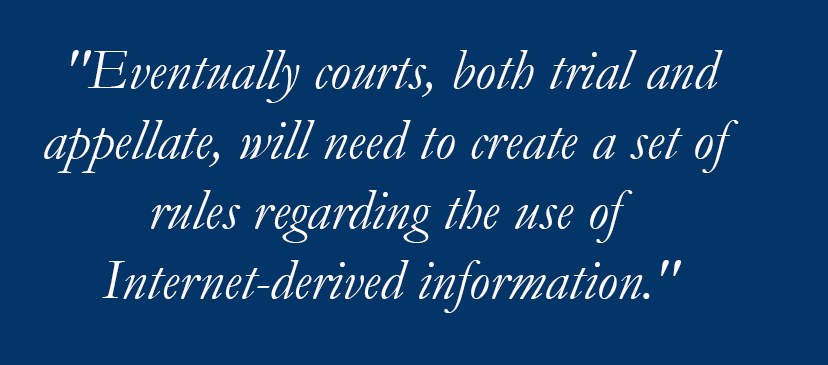In recent years it has become increasingly common for Courts to base their decisions on facts obtained through Internet searches. These searches are not conducted by the parties; nor are they subject to oversight or cross-examination through the adversarial process. They are performed by the Courts and often the information they obtain is crucial to their decisions.
Google map photos, life expectancy tables, weather reports, mathematical formulas, published government statistics, and other reasonably reliable sources of information are routinely utilized by Courts around the country. See, e.g. United States vs. Perea-Rey, 680 F.3d 1179, 1193 (9th Cir. 2012)(“We take judicial notice of a Google map and satellite image as a “source[] whose accuracy cannot reasonably be questioned,” at least for the purpose of determining the general location of the home.”).1
In addressing this practice, the first questions to be asked are not only whether the facts obtained through an Internet search are reliable, but whether each side has a right and opportunity to set forth their position regarding the underlying validity of each fact obtained, and what, if any, significance should be given to it.
When an Appeals Court obtains facts without inviting each side to address these new extra-judicial pieces of information what’s occurring is that the record on appeal is being supplemented but without notice and an opportunity to be heard from either side. The Court is thus left without each side’s take on what to make of these new facts that have never before been part of the record or subject to any kind of adversarial testing, examination, or interpretation.
As well, some  Internet searches can be said to be inaccurate and incomplete. Researching technical questions—such as the stopping distance of motor vehicles involved in car accidents or the doubling time of a particular form of cancer—may at first seem to achieve reasonably reliable results, but in fact such questions are often vigorously contested during the trial itself with opposing experts, and thus by no means can be said to be settled, established, or uncontradicted.
Internet searches can be said to be inaccurate and incomplete. Researching technical questions—such as the stopping distance of motor vehicles involved in car accidents or the doubling time of a particular form of cancer—may at first seem to achieve reasonably reliable results, but in fact such questions are often vigorously contested during the trial itself with opposing experts, and thus by no means can be said to be settled, established, or uncontradicted.
In addition, some published scientific literature may in fact be unreliable. In 2009, Dr. Marcia Angell, then Editor-in-Chief of the New England Journal of Medicine, wrote: “It is simply no longer possible to believe much of the clinical research that is published, or to rely on the judgment of trusted physicians or authoritative medical guidelines. I take no pleasure in this conclusion, which I reached slowly and reluctantly over my two decades as an editor of The New England Journal of Medicine.”2
In 2015, Dr. Richard Horton, then Editor-in-Chief of the Lancet, wrote: “The case against science is straightforward: much of the scientific literature, perhaps half, may simply be untrue. Afflicted by studies with small sample sizes, tiny effects, invalid exploratory analyses, and flagrant conflicts of interest, together with an obsession for pursuing fashionable trends of dubious importance, science has taken a turn towards darkness.”3
While a Court may act with the best of intentions in seeking out an independent and unbiased source, in fact it may be inadvertently inviting inaccuracy and error into its decision-making. If the Editors of two prestigious medical journals have expressed doubt over the reliability of at least some of the published scientific literature, Courts as well would be well advised to tread with caution in this area.
This is why juries in Illinois are instructed not to perform their own Internet searches on the issues before them. Eventually courts, both trial and appellate, will need to create a set of rules regarding the use of Internet-derived information. A first thought would be to recognize the importance of notice and the right to be heard before any Internet-based facts are considered or incorporated into the record.
The above is not meant to suggest that the increasingly rich, valuable, and rapidly growing resources of the Internet should not have a role in our Court system. They should—just an utterly transparent one.
1See also McCormack v. Hiedeman, 694 F.3d 1004, 1025 (9th Cir. 2012)(“It is about 138 miles from Bannock County, Idaho to Salt Lake City, Utah. This Court takes “judicial notice of a Google map and satellite image…”).
2Marcia Angell, Drug Companies & Doctors: A Story of Corruption, New York Review of Books (January 15, 2009) http://www.nybooks.com/articles/2009/01/15/drug-companies- doctorsa-story-of-corruption/
3Richard Horton, Offline: What is medicine’s 5 Sigma? (The Lancet, Vol 385, Pg.1380, April 11, 2015). http://www.thelancet.com/pdfs/journals/lancet/ PIIS0140-6736%2815 %2960696-1.pdf




